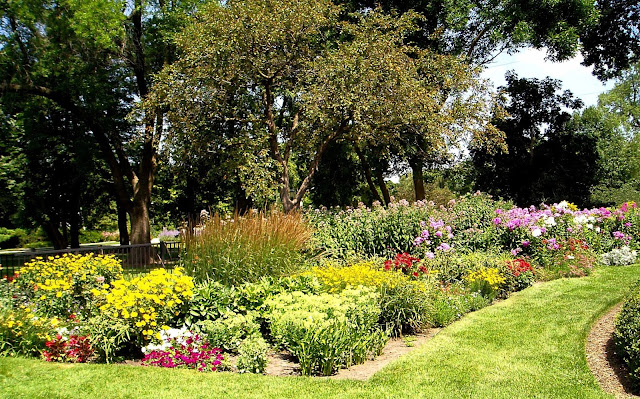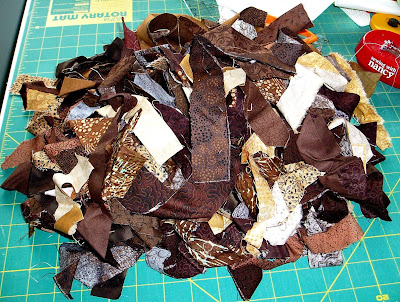Hi all, and welcome back to the Classic Stitches row quilt! This month's color is red, a hot and snappy color for a hot and snappy month!
Here is this month's block:
This block has two common names: Broken Dishes Variation, and The Chinese Block. According to Barbara Brackman's
Encyclopedia (#2065), the Broken Dishes name dates to 1930. There is a reason I chose this block for the red month--this is the block that inspired this whole quilt. I hope you'll indulge me while I tell you about it. Look at this example of the block:

This block was made about 80 years ago by my great-grandmother and is one of my most treasured possessions. I keep it in a shadow box out of the sun in my sewing room because the muslin is fragile and I don't want the red to fade. It was hand-pieced with black and white thread and nothing in it is a "standard" size. It is precious not just because it was made by my great-grandmother and it's lovely, but also because of its flaws. Every time I start getting upset because my blocks aren't perfect or my seam allowance is off or my (modern electronic) machine is messing up, I try to remember to look at this lovely block and remember that it was cut with scissors, probably from leftovers, stitched by hand, has varying seam allowances, no two pieces are the same size, and yet is treasured so many years later over perfectly-sized, consistent, "accurately-pieced" blocks. It's a humbling reminder that perfection can be seriously over-rated and a quilt that's loved is more beautiful than one that's technically perfect.
Thanks for indulging my little nostalgic episode. On to the directions!
Directions are for a 6-inch finished block. Directions for other sizes, including a 12-inch block, are given after the assembly instructions. There are a lot of pieces here and not a lot of room for simplification, but if you break it down into the steps given, assembly of this block should go fairly quickly. If you are considering making a bigger block for one of your rows, this could be a good month for it.
Cutting:
For a 6-inch finished block, you will need a red and a background color. My background is white. From the red, cut 2 2-7/8 inch squares (not for hsts, so don't oversize), 4 1-1/2 inch squares, one 2-1/2 inch square, and an additional 8 1-1/2 inch squares.** From the background, cut one 3-1/4 inch square, 4 1-1/2 by 2-1/2 inch rectangles, and 8 1-1/2 inch squares.** (**NOTE: These 8 squares are used to make 1-1/2 inch half-square triangles using the method described below. If you prefer to make these differently, use 4 1-7/8 inch squares of each color.)
Construction:
First, make the half-square triangles. Each block needs 8 1-1/2 inch hsts that will finish at 1 inch. Yikes! For half-square triangles this small, I like to make what I call "cheater" hsts. These waste a tiny little bit of fabric but save a lot of time and fuss. To make the cheater hsts, take the 8 background squares and 8 of the red squares. Match them up and then draw a line diagonally from corner to corner of the background square.
Stitch right on that line. Really! Trim 1/4 inch away from the stitching line, open, and press. You should be left with 1-1/2 inch half-square triangles.
See that little bit that's wasted? I'm okay with wasting it for this fast, no-trouble method. (Of course, if you'd rather, make 8 hsts that will finish at 1 inch using any method you want.)
Now that you have the hsts, match them up with the 1-1/2 by 2-1/2 inch rectangles. Lay them out as shown:
Stitch as shown. Make 4 of these short sides.
To make the longer sides, take 2 of the short sides and the remaining red 1-1/2 inch squares. Lay the short side units and the squares out as shown:
Attach the red squares to make 2 longer sides. Put these aside until we get to the final assembly.
The next step is to make the center square-in-a-square unit. Take the background 3-1/4 inch square and cut it diagonally twice to make 4 pieces:
Attach these to the sides of the red 2-1/2 inch square. Finger-press the centers of each piece to make it easier to match up the sides properly.
Trim the dog ears and press well. Your final unit should look like this and measure 3-3/8 inches:
Note: If you want to simplify the construction of this block, you can simply skip the center red square and begin with a background square that measures 3-3/8 inches. As long as you complete the next step and add the red triangles to the background square, the general look of the block will be simpler, but the effect will be preserved. Here's what a modified block looks like:
The next step is to cut the remaining 2 red squares (2-7/8 inches) in half from corner to corner. Repeat the square-in-a-square process, attaching the red triangles to the square-in-a-square unit that was just constructed. Finger-press the triangles to match the centers and stitch.
The completed unit should measure 4-1/2 inches square.
Okay, finally time to assemble the block! Lay out the pieces as shown:
Stitch together carefully, taking special care with matching the triangle points in the corners to preserve the straight line in the finished block.
And here's a picture that brings tears to my eyes:
 |
| Made about 80 years apart! |
Anyone else have something in their eyes?
Okay, your block should measure 6-1/2 inches to finish at 6 inches in the quilt. Ten of these blocks will make a 60-inch finished row, and six will make a 36-inch row.
Variations:
You can always switch the colors for white blocks on a red background.
Try using a different color for the center square and/or the corner squares for a different look.
Larger pieces make this block much simpler. I chose to make 7-1/2 inch blocks. The cutting sizes are a little strange, but they turn out great. For this size, cut one 3-3/4 inch sqaure from background, along with 4 1-3/4 by 3 inch rectangles and 4 2-1/8 inch squares for making hsts. From red, cut 2 3-3/8 inch squares, one 3-inch square, 4 1-3/4 inch squares, and 4 2-1/8 inch squares for hsts. Eight 7-1/2 inch blocks make a 60 inch row.
This block looks great in a 12-inch size. For a 12-inch block, cut one 5-1/4 inch square of background, along with 4 2-1/2 by 4-1/2 inch rectangles and 4 2-7/8 inch squares. From the red, cut 2 4-7/8 inch squares, 4 2-7/8 inch squares, 4 2-1/2 inch squares, and one 4-1/2 inch center square.
Here are my three sizes--6-inch, 7-1/2 inch, and 12-inch:
And if you are just making a few of each block, here is an idea for a Christmas quilt:
Don't the red and green blocks look great together?
Thanks for coming along on this emotional sewing experience with me! Enjoy making these blocks and come back on August 4 for our next row!
Linking to
Tips and Tutorials Tuesday and also
soscrappy for RSC15.





























































